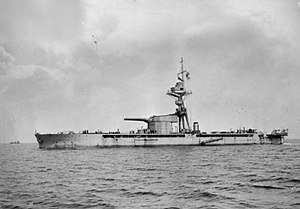HMS Marshal Ney
 HMS Marshal Ney, August 1915 | |
| History | |
|---|---|
| Name: | HMS Marshal Ney |
| Builder: | Palmers, Jarrow |
| Launched: | 17 June 1915 |
| Commissioned: | August 1915 |
| Fate: | Scrapped 1957 |
| General characteristics | |
| Class and type: | Marshal Ney-class monitor |
| Displacement: |
|
| Length: | 355 ft (108 m) |
| Beam: | 90 ft (27 m) |
| Draught: | 10 ft 6 in (3.20 m) |
| Installed power: | 1,500 hp (1,100 kW) |
| Propulsion: |
|
| Speed: |
|
| Complement: | 187 |
| Armament: |
|
| Armour: | |
HMS Marshal Ney was a Royal Navy Marshal Ney-class monitor constructed in the opening years of the First World War. Laid down as M13, she was named for the French general of the Napoleonic Wars Marshal Michel Ney. After service in World War I she became a depot ship and then a stokers' training ship. Between 1922 and 1947 she was renamed three times, becoming successively Vivid, Drake and Alaunia II. She was broken up in 1957.
Design
Designed for inshore operations along the sandbank strewn Belgian coastline, Marshal Ney was equipped with two massive 15-inch (380 mm) naval guns. Originally, these guns were to have been stripped from one of the battlecruisers Renown and Repulse after they were redesigned. However, the guns were not ready, and guns intended for the battleship Ramillies were used instead.
The diesel engines used by the Marshal Ney-class ships were a constant source of technical difficulty, hampering their use. Marshal Ney in particular was—in the words of Jane's Fighting Ships—"practically a failure", on account of her MAN diesel engines being so unreliable. A contemporary description of the engines by Admiral Reginald Bacon, commander of the Dover Patrol from April 1915, shows how fault-prone they were:
- " Reliability both in officer and a ship is the first thing that an Admiral values. The Marshal Ney, judged by this standard, was a hopeless sinner; but her officers and men made up for her deficiencies. Her engines not infrequently exploded when asked to start; her engine-room was scarred as if by shrapnel from the fragments of burst cylinder heads, and the escapes of the engine-room staff were miraculous. Her Chief Engineer, Mr. Swan, stuck to the engines like a Trojan and almost overcame their bad habits; and really, when talking to him, you were almost converted to the opinion that just one little alteration would make them start next time the ship was required. Added to this, when they did not burst, they usually would not start, and when once started no one liked to stop them for fear of not being able to start them again. But, without exaggeration, the more they burst and the worse they behaved, the more Mr. Swan loved them and the more cheery Captain [Hugh J.] Tweedie became."[1]
Service
Assigned to the Dover Patrol, Marshal Ney served with her sister ship HMS Marshal Soult.[2] In 1916, her 15-inch barbette was stripped off and given to Erebus, launched in the same year and joining the Dover Patrol along with HMS Terror.[3] Marshal Ney was then rearmed with a single 9.2-inch (230 mm) gun and four 6-inch (150 mm) guns for service as a guardship for The Downs. She engaged German destroyers during a raid on Ramsgate in April 1917.
During 1919, Marshal Ney was used as a base ship at Queenborough, before being disarmed and becoming a depot ship at Fort Blockhouse from 1920. Renamed Vivid in June 1922, she then served as a stoker training ship until 1957. She was again renamed Drake in January 1934, and Alaunia II in 1947.
Fate
She arrived at Thos W Ward's shipyard at Milford Haven on 6 October 1957 for breaking up.
References
- Notes
- ↑ Bacon 1919, vol. 1, p. 62.
- ↑ Bacon 1919, vol. 1, pp. 61-64.
- ↑ Bacon 1919, vol. 1, p. 63.
- Sources
- Bacon, Reginald (1919). The Dover Patrol 1915-1917. (2 vols.). New York: George H. Doran Co. Vol. 1 • Vol. 2
- Dittmar, F. J. & Colledge, J. J., "British Warships 1914-1919", (Ian Allan, London, 1972), ISBN 0-7110-0380-7
- Gray, Randal (ed), "Conway's All The Worlds Fighting Ships, 1906-1921", (Conway Maritime Press, London, 1985), ISBN 0-85177-245-5